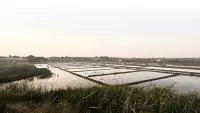
The salt worker's trade: a skill combining passion and tradition
For centuries, the profession of salt worker has combined ancestral know-how, teamwork and idyllic surroundings. A unique and attractive profession, taught at the École des paludiers, which trains new recruits every year with a passion for nature and tradition.
The salt workers' school
In 1979, as the price of salt rose and aspiring salt workers became scarce, a training course dedicated to the artisanal profession of salt worker was born: the BPREA saliculture. Its aim is to introduce future operators to the upkeep of salt marshes and the very precise techniques of harvesting salt by hand.
Dispensed at the Ecole de Formation par l'Expérience en Agriculture de la Turballe, this one-year training course is a skilful blend of theory and practice to promote an integral understanding of the profession and the industry. The salt workers are keen to pass on their values of mutual aid and solidarity, which are essential to the smooth running of the cooperative.
At the end of this training, new graduates join the ranks of the salt workers. The promise of great autonomy in the organization of their work, as well as a real connection with nature, in a preserved environment.
A wide range of profiles
There's no age or gender barrier to becoming a salt worker, the profession is open to anyone with a passion for manual labor and the great outdoors. The Salines de Guérande cooperative brings together over 220 salt workers aged 25 to 55, including 30 women. Some begin their activity as seasonal workers, while other salt workers discover this vocation years later following a reconversion project.
"Organizational skills, determination and good physical condition are essential qualities for a salt worker", explains Thibault, a salt worker for the past 10 years at the Guérande marshes.
A rich, technical vocabulary
For the saltworks:
- Œillet:salt crystallization and harvesting basin
- Mulon: salt stockpile deposited on the edges of the saltworks after harvesting
- Ladure: storage platform for the harvest of an eyelet
- Fare: the saltworks' first evaporation basin
- Chaussage: refurbishment of saltworks basins
Find more technical words in le dico du paludier.
For tools:
- Bridging kit:wooden tools used to reshape bridges in spring
- Houlette:shovel used to clean mudflats, étiers and remove or move clay
- Flowering kit: collect the Fleur de sel when harvesting
Discover all the other paludier's tools.
The harvest period: short and intense
Intense, the harvest season is rather short. It lasts an average of 40 to 45 days a year, during the hottest periods of the year, i.e. spring and summer.
For a good harvest, it's all a question of organization and timing: the salt must be taken without delay, a few hours after it has formed. This is why each salt worker employs 3 or 4 seasonal workers to support him in his task (picking the Fleur de sel, carrying the coarse salt)
Key figures
A minimum of 210 grams of salt per L/water is required to obtain good quality salt. Every year, over 12,000 tonnes of salt are harvested by members of the cooperative. Once harvested, the salt is deposited in mulons around the saltworks and then taken to the cooperative, which is responsible for storing and marketing it.
The rest of the year dedicated to maintenance and preparation
Between harvest periods, there's no shortage of work. Maintaining and preparing the salt pans requires a great deal of time, precision and patience. In fact, every year, the salt pans are dried out and the clayey silt from the bottom is used to rebuild the bridges that are damaged during the winter.
This period strengthens the bonds between paludiers, who help each other and work together to keep the marshes running smoothly.
Every 20-25 years, the "chaussage des œillets" takes place. The salt workers get together in teams to refurbish the bridges and bottoms of carnations that are no longer in working order. This activity takes place outside harvesting periods, generally from autumn to spring.

"To discover the salt worker's trade, visit us to watch us at work and immerse yourself in our working environment", advises Thibault to future salt workers.




